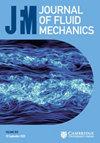A numerical study on the turbulence characteristics in an air–water upward bubbly pipe flow
IF 3.9
2区 工程技术
Q1 MECHANICS
引用次数: 0
Abstract
A high-resolution numerical simulation of an air–water turbulent upward bubbly flow in a pipe is performed to investigate the turbulence characteristics and bubble interaction with the wall. We consider three bubble equivalent diameters and three total bubble volume fractions. The bulk and bubble Reynolds numbers are空气-水上升气泡管流中湍流特性的数值研究
我们对管道中的空气-水湍流向上气泡流进行了高分辨率数值模拟,以研究湍流特性以及气泡与管壁的相互作用。我们考虑了三种气泡等效直径和三种气泡总体积分数。体积和气泡的雷诺数为 $Re_{bulk}= u_{bulk}D/\nu _w = 5300$ 和 $Re_{bub}= (\langle u_{bub}\rangle - u_{bulk}) d_{eq}/\nu _w = 533\unicode{x2013}1000$ ,其中 $u_{bulk}$ 是水的体积速度、 $\langle u_{bub}\rangle$ 是整个气泡的平均速度,$D$ 是管道直径,$\nu _w$ 是水的运动粘度。由于气泡与管壁的相互作用,管壁附近的平均水流速度显著增加,且均方根水流速度波动与 $\bar {\psi }(r)^{0.4}$ 成正比,其中 $\bar {\psi } (r)$ 是平均气泡速度。(r)$ 是平均气泡体积分数。在所考虑的情况下,气泡引起的湍流抑制了剪切引起的湍流,并成为所有径向位置(包括靠近壁面)的主要流动特征。靠近壁面的上升气泡大多会反弹到壁面上,而不是沿着壁面滑动或悬挂在壁面周围而不发生碰撞。由于气泡的反弹,在没有气泡的近壁区域观察到的低速条纹几乎消失。这些反弹气泡在其尾部产生反向旋转漩涡,并通过将高速水流卷向壁面来增加表皮摩擦力。我们还提出了一个代数雷诺平均纳维-斯托克斯模型,该模型考虑了剪切诱导湍流和气泡诱导湍流之间的相互作用。该模型可对各种液体体积雷诺数进行精确预测。
本文章由计算机程序翻译,如有差异,请以英文原文为准。
求助全文
约1分钟内获得全文
求助全文
来源期刊
CiteScore
6.50
自引率
27.00%
发文量
945
审稿时长
5.1 months
期刊介绍:
Journal of Fluid Mechanics is the leading international journal in the field and is essential reading for all those concerned with developments in fluid mechanics. It publishes authoritative articles covering theoretical, computational and experimental investigations of all aspects of the mechanics of fluids. Each issue contains papers on both the fundamental aspects of fluid mechanics, and their applications to other fields such as aeronautics, astrophysics, biology, chemical and mechanical engineering, hydraulics, meteorology, oceanography, geology, acoustics and combustion.

 求助内容:
求助内容: 应助结果提醒方式:
应助结果提醒方式:


